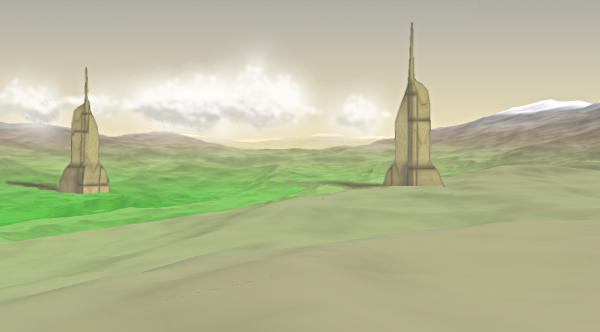BY LETTER
Arcology
Technology > Technology Type or Material > Drytech/Hylotech
Culture and Society > Technology Levels in Society > High Tech Societies
Technology > Application > Infrastructure
Technology > Technology Levels > Middle Tech / Midtech
Culture and Society > Technology Levels in Society > High Tech Societies
Technology > Application > Infrastructure
Technology > Technology Levels > Middle Tech / Midtech
 Image from Matthew C. Johnson |
Term coined by the visionary Atomic Age Old Earth architect Paolo Soleri in 10 BT (1959 c.e.) to describe the concept of Architecture and Ecology working as an integral system.
The result is a planned, building/neighborhood/city that is integrated into the landscape and enables the inhabitants to live holistic lives, integrating work and play. Arcology designs are fully 3-dimensional, mega-structure cities which can in theory achieve much greater efficiencies, and promote more social interaction than 2-dimensional cities, while using far less land and consuming fewer resources.
Soleri's movement lured a community of architecture students to Arcosanti, Arizona, USA to study, but the movement fell apart during the middle Information Age. The arcology meme however had already been established in popular fiction (especially cyberpunk rpging and early virch) as a gigantic, more-or-less self-contained building /community, usually with businesses and industries built in, a city-in-a-building, with the implication of the various sociopolitical consequences thereof. Such corporate arcologies of popular fiction were seen as the places where sinister forces and their minions did their work.
Especially during the early to middle Interplanetary age, Arcologies did connote isolation and exclusiveness, but this was less because of any prophetic post-apocalyptic literature and more because one already needed wealth and connections to live in the luxurious and safe apartments that these communities offered. During the nanotech period the tables were turned, and arcolgans found themselves locked out of the resources of the countryside that provided raw materials for the nanite craze. However, the ai-controlled and blue-goo shielded nature of the arcologies meant that their inhabitants had the best chances during the nano-plagues and nano-swarm years, and most survived without mishap (in contrast, the country- and suburban-dwellers suffered very high casualty rates)
Because of the extreme restrictions on space and resources that go along with inhabiting garden worlds and even terraformed previously hostile planets, the arcology model has indeed turned out to be the most optimal one for planetside communities. Apart from out in the Periphery and on some newly terraformed worlds, almost all planetside cities are arcological or quasi-arcological in nature. Often even on closed environment colonies, a large habitat dome will include one or two arcologies among a garden-like biospheric setting. Arcologies are also popular on high density orbitals, where they enable maximum population densities with minimum resource demand.
Ironically, the arcology meme has come full circle - from a place for the secluded and elite technosavvy upper-middle class it has become a lifestyle setting for those without wealth or resources to own or live in their own habitat or planetary wide surface.
 Image from Steve Bowers |
Related Articles
Appears in Topics
Development Notes
Text by Anders Sandberg, Trent Shipley, and M. Alan Kazlev
Initially published on 07 October 2001.
Initially published on 07 October 2001.
Additional Information
A video by Isaac Arthur discussing several factors impacting arcology design.






